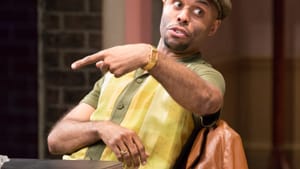Stay in the Loop
BSR publishes on a weekly schedule, with an email newsletter every Wednesday and Thursday morning. There’s no paywall, and subscribing is always free.
The black experience then and now
August Wilson's 'Two Trains Running' at the Arden (second review)

A lot happened in 1969. Nixon became president; Neil Armstrong and Buzz Aldrin walked on the moon; Chappaquiddick, Stonewall, Woodstock, My Lai, and Charles Manson all entered the national vocabulary. Very little of this penetrates the world of Memphis Lee’s Pittsburgh diner in August Wilson’s Two Trains Running, except through the images projected above the set and the voices that can be heard during scene changes.
Two Trains Running is part of Wilson’s Pittsburgh Cycle, also called his “Century Cycle,” ten plays that explore the African-American experience during the 20th century. Some, such as Fences and The Piano Lesson, have had recent Philly productions, others are less known. All but one of them, Ma Rainey’s Black Bottom, are set in Pittsburgh’s Hill District. In 1969, the year of the play, that neighborhood was undergoing urban renewal.
Matters of life and death — the life and death of the black community as well as its individual members — preoccupy the denizens of Memphis’s (Johnnie Hobbes Jr.) diner. Memphis knows that his diner can be taken over by the government through eminent domain, but he wants a fair price for the place. He is the voice of reason in a world of people trying to find shortcuts to happiness and success.
Nuanced characterization
Each actor embodies the nuances of how the character he or she is playing eats and sits and talks. The play occurs over time; each day, when the characters arrive in the diner, they go through their little routines and we gradually get to know them.
Hambone, a childlike innocent (Kash Goins) who slips back and forth between character and narrator, also wants what he believes he is owed — the ham he was promised by the white butcher in return for painting his fence. His primary lines are a mumbled “I want my ham,” and yet Goins creates a character of pathos and sympathy. Ex-con Sterling (U.R.) is a con man throughout, always looking for the next scheme, and the numbers runner Wolf (Darian Dauchan) can’t stop hustling; philosopher Holloway (Damian J. Wallace) sits and reads and observes it all.
Death lurks in the background throughout. Although only mentioned once, the 1969 assassination of Martin Luther King occurred not that long before, and a rally for slain activist Malcolm X is planned in the near future. Undertaker West (E. Roger Mitchell) stops in to chat, and the characters discuss the Prophet Samuel, who is laid out at the nearby funeral parlor with all his jewels.
It’s a cumbersome play, wordy and meandering. Each character speaks in monologues rather than to each other, although there is a moment in the second act, when Sterling dances with Risa (Lakisha May), that offers is a sense of connection between them.
The same conversations
What resonates the most, though, is that we are still having the same conversations about race relations and what it means to be black in a white world. I can only write about this as the outsider, the observer. So I find myself asking questions I can’t answer.
We talk about diversity in theater, and here is a play by a black playwright, directed and performed by black actors, performed for a mostly white audience. What does that mean exactly? Are we anthropologists studying another culture through their artifacts? How do we accurately evaluate what we are seeing?
When I write about women’s issues in a play, I bring to it my lived experience as well as my education in women’s history and women’s rights. This play, with its treatment of the one female character who mutilates herself is ripe for that kind of discussion, but I lack the contextual experience of the black female to give it justice.
There’s a level at which I am not qualified to speak. So I write about the talent of the actors, the reality of the set, the length of the script, and still feel that I haven’t even scratched the surface of what the play is about.
For Frank Burd’s review, click here.
What, When, Where
Two Trains Running by August Wilson. Raelle Myrick-Hodges directed. Through April 10, 2016 on the F. Otto Haas Stage at Arden Theatre Company, 40 N. 2nd Street, Philadelphia. (215) 922-8900 or ardentheatre.org.
Sign up for our newsletter
All of the week's new articles, all in one place. Sign up for the free weekly BSR newsletters, and don't miss a conversation.

 Naomi Orwin
Naomi Orwin